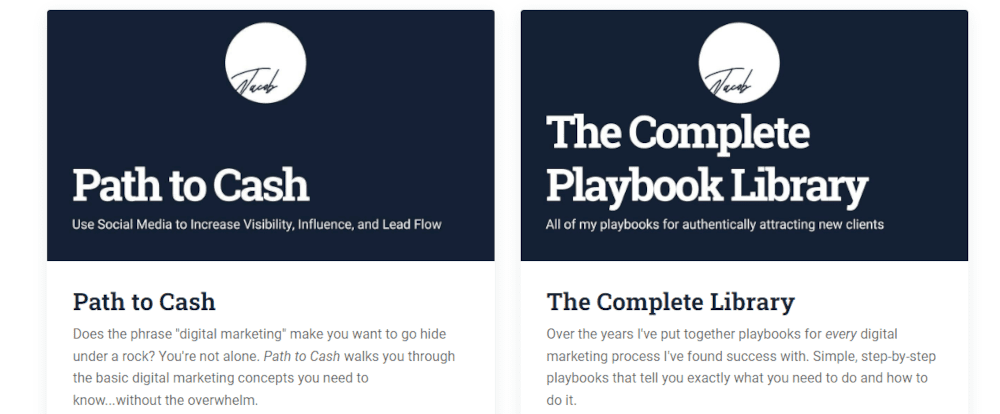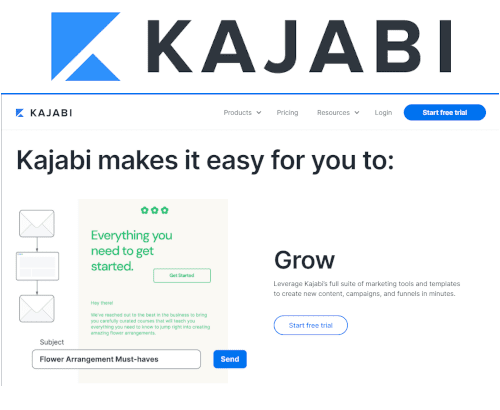Our content is reader supported, which means when you buy from links you click on, we may earn a commission.
How Jacob Ratliff Created the Organic Client Attraction System as a Lower-Priced Option to His 1:1 Coaching Program

- Who: Jacob Ratliff
- Website: jacobratliff.com
- Course Topic: Business Coach
- Interesting Stats: $50k in the 1st Year from His Online Course
Who are you and what course have you created?
I am a Client Attraction Coach and Business Coach, and I work with high-impact coaches and consultants to help them leverage social media to generate leads and attract new clients. I not only work with 1:1 and group coaching clients but also share my Organic Client Attraction System via a self-paced online course.
Designed to be fully implemented in around 12 weeks, the Organic Client Attraction System walks entrepreneurs through the entire process of implementing their own client attraction process, including:
- Getting absolute clarity on who their ideal client is, including their pain points, desires, and goals.
- Creating or fine-tuning their coaching or consulting offer, including packaging, pricing, and messaging.
- Leveraging social media to find their ideal clients, get in front of them, and connect with them.
- Filling their calendar with warm, qualified prospective clients.
- Successfully selling and enrolling new coaching clients.
What market does your online course serve?
The Organic Client Attraction System works for any coach, consultant, or even service provider, but ultimately serves high-impact coaches and consultants who want to enroll new clients ethically and effectively, and who do not want to use the manipulative sales tactics that so many business coaches are teaching.
 What’s the biggest benefit of taking your course?
What’s the biggest benefit of taking your course?
The biggest benefit of the Organic Client Attraction System is that by the end of the program, students will have a start-to-finish lead generation and client attraction process in place. With this system in place, students are able to get as many coaching clients as they want.
How did you get into the market?
I began my career with a focus on digital marketing, and several years ago transitioned into the business coaching space. I focused entirely on serving my 1:1 and group coaching clients, and along the way, I created a wealth of online training content that was exclusive to my private coaching clients.
At the same time, I was hearing from a lot of coaches who really wanted to work with me but who at that point couldn’t make the financial commitment. In response to that feedback, I revamped and repackaged my online training content and turned it into a self-paced online course.
This dramatically expanded the number of coaches and consultants who were able to implement my system for generating qualified leads.
Why did you decide to create an online course in the first place?
I originally had no interest in creating an online course, but when I was hearing from prospects who needed my process but who couldn’t afford to work with me 1:1, I realized that I had to respond to market demand and create a more cost-effective option to help my clients get results.
Did you have any moments of doubt before you created/launched it?
One of the great things about my journey in creating this online course was that by the time I decided to create an online course, I had already created the majority of the content working with my coaching clients.
Because I took the approach I did, I had several key things out of the way:
- Validation: Because I created this content for my private clients as they needed it, and the course was geared towards a similar target audience, I knew that I was creating something they needed and wanted.
- Confidence: Because I had been working with private coaching clients prior to creating the course, I knew that what I was teaching was something that gets my clients results.
What’s your online course like?
The course is primarily video content, and the videos in it vary in format. Some are screen share videos so I can show students the nitty-gritty details of the implementation process, while others are slide decks when I need to explain key concepts.
Every module and lesson, though, has a set of action items for students to complete so they can stay on track with their implementation.

How long did it take you to create your course?
Counting the time before I even realized I was creating an online course, it took roughly two years for me to create it. That’s largely because at that time I thought I was just creating training content for my coaching clients––not creating an online course.
Once I made the decision to create this course, though, the course was live within two months. Here’s what those two months looked like:
- I took inventory of all the training content I had already created and identified which lessons were good to go and which ones needed to be redone. From there, I mapped out the 12-week flow of the course, identifying the sequence of the lessons and modules.
- I created the course content––those lessons that needed to be redone and the new lessons I needed to create.
- Then, I designed the sales assets for the course, including the funnel, landing pages, email sequences, and everything else that I needed to sell the course.
- I built the course itself in Kajabi, adding the videos, action items, worksheets, templates, and resources.
Tell us a little about the process of launching your course and getting your first sale(s).
I first launched the course to my email list using a 5-day email sequence, and at the same time running an organic social media campaign using Facebook and Instagram.
My first sales came from those efforts, but the majority of my sales have come since then. My initial launch was not lucrative or wildly successful. Rather, where my course has been most successful is in the time since launch.
Do you have a lead magnet?
I have a free online training (20 minutes) that I use as a lead magnet. A course is also a popular option when my sales team is talking with prospective clients who, for a variety of reasons, may not yet be an ideal fit for a private coaching relationship with me.
What’s the traffic strategy that works best for you?
The best traffic strategy for me has been getting in front of other people’s audiences by getting on podcasts. It has gotten me in front of thousands of people and is both a time and cost-effective strategy.

What online course platform are you using?
I use Kajabi for delivering my online course.
Kajabi is the All-In-One Course Platform
Kajabi is one of the top online course platforms used by successful course creators interviewed on coursemethod.com. Kajabi includes email marketing and other tools that make it easy to run your entire business from their platform.
- Price Range: $149 to $399/month
- Most Popular Plan: Growth Plan at $199/month
- Annual Discount: Yes, take 20% off!
- Free Trial: Get a 14-day free trial (credit card required)
Do you like it?
I love Kajabi! It’s a bit pricey, but for me is absolutely worth it.
Are there any features you wish it had?
Kajabi is a one-stop shop for both marketing and selling an online course, and the only feature I wish it had on the marketing and sales side is better support for order bumps and one-click upsells. However, I use ThriveCart for the actual checkout process for the course, as it gives me more control over the sales process.
What made you decide to use your chosen platform over others?
I chose Kajabi because I wanted the simplest and most intuitive platform. I had been a student on Kajabi-hosted courses before and really liked how they looked on the user end as well.
What other tools do you use to run your online course business?
I use so many different tools, it can be overwhelming at times. I mentioned ThriveCart, but I also depend heavily on Loom, Calendly, Buffer, Monday.com, and Otter.ai.
What books or training programs have you found useful on your journey to a successful business owner that others might find valuable too?
In regard to the course creation process, I am largely self-taught (more on that below), but in terms of the marketing and sales aspects of selling an online course, I highly recommend Jeff Walker’s Product Launch Formula (although it is in some ways a tad outdated these days).
Do you have any big mistakes you’ve made along the way that you’d be willing to share?
Because I’m mostly self-taught and have learned through continuous experimentation, I have made plenty of mistakes throughout the process. Here are a few lessons:
- You don’t have to create your course content before selling your course. Just create the first week or two’s worth so you can focus on generating revenue. No one wants to do work they’re not getting paid for.
- During the course creation process, spend plenty of time upfront on project planning. Ensuring that you do things in the right order will save you so much time in going back and fixing things.
- Your course content doesn’t have to be professionally produced and flawless. Saying “um” or tripping over your words once or twice is not the end of the world.
Please share some idea of revenue.
In 2021––the year I launched the Organic Client Attraction System––it generated $50k.

Please tell us a little about what the money you’ve earned from your course has done for you.
As a result of the success with the Organic Client Attraction System, I have been able to spend less time coaching. While I love coaching my clients, I also highly value time spent not working. The revenue from this course has dramatically increased my free time and my capacity to pursue other interests. And because I’m a natural-born entrepreneur, many of those interests tend to be work-related passion projects anyway.
In addition to revenue are there any numbers you would like to share?
Within 24 hours of being featured on NYT Bestselling Author Chris Guillebeau’s podcast Side Hustle School, I added 150 new subscribers to my email list.
What has creating your course done for you personally?
Creating this course has helped me expand my reach dramatically and help so many more entrepreneurs than I would’ve been able to by focusing only on 1:1 and small group coaching. - Jacob Ratliff Click To TweetDo you have a story of a transformation from any of your clients?
One of my clients entered my program after spending the prior 12 months running unsuccessful Facebook Ads and webinars. She had not signed a single client.
Three months later, her Facebook Group had grown from 300 to 1,000 members, and she had an effective client attraction process in place to enroll new clients effortlessly.
What advice do you have for people just starting out?
The #1 piece of advice I have for people just getting started is that you don’t need a massive audience to have a successful online course.
All you need to do is get your course in front of the right people. If you can consistently get your course in front of the people it’s meant for, then it doesn’t matter the size of your social media following or email list. - Jacob… Click To TweetLearn more about Jacob Ratliff of jacobratliff.com:
- Website: jacobratliff.com
- Client Attractor: Book
